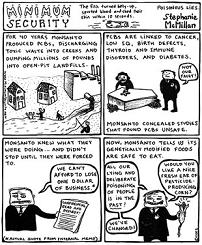In what is being described as the most comprehensive study of the effects of genetically modified (GM) foods on mammalian health, researchers have linked organ damage with consumption of Monsanto's GM maize. All three varieties of GM corn—Mon 810, Mon 863, and NK 603—were approved for consumption by U.S., European, and several other national food safety authorities. Made public by European authorities in 2005, the confidential raw data of Monsanto's 2002 feeding trials on rats, which was used to approve GM corn in different parts of the world, is the same data, ironically, that the new team of researchers analyzed.
 |
|
(click to enlarge) |
The Committee of Research and Information on Genetic Engineering (CRIIGEN) and Universities of Caen and Rouen studied Monsanto's 90-day feeding trials data of insecticide producing Mon 810, Mon 863, and Roundup herbicide absorbing NK 603 varieties of GM maize. The data "clearly underlines adverse impacts on kidneys and liver, the dietary detoxifying organs, as well as different levels of damages to heart, adrenal glands, spleen, and haematopoietic system," reported Gilles-Eric Séralini, a molecular biologist at Caen University.
Although different levels of adverse impact on vital organs were noticed between the three GMOs (genetically modified organisms), the 2009 research shows specific effects associated with consumption of each GMO, differentiated by sex and dose. Their December 2009 study appears in the International Journal of Biological Sciences (IJBS). This latest study conforms with a 2007 analysis by CRIIGEN on Mon 863, published in Environmental Contamination and Toxicology, using the same data. Monsanto rejected the 2007 conclusions, stating: "The analyses conducted by these authors are not consistent with what has been traditionally accepted for use by regulatory toxicologists for analysis of rat toxicology data."
In an email, Séralini explained that their study goes beyond Monsanto's analysis by exploring the sex-differentiated health effects on mammals, which Monsanto ignored: "Our study contradicts Monsanto conclusions because Monsanto systematically neglects significant health effects in mammals that are different in males and females eating GMOs or not proportional to the dose. This is a very serious mistake, dramatic for public health. This is the major conclusion revealed by our work, the only careful re-analysis of Monsanto crude statistical data."
When testing for drug or pesticide safety, the standard protocol is to use three mammalian species. The subject studies used only rats, yet won GMO approval in more than a dozen nations. In addition, chronic problems are rarely discovered in 90 days. Most often such tests run for up to two years. Tests "lasting longer than three months give more chances to reveal metabolic, nervous, immune, hormonal or cancer diseases," wrote Seralini et al in a rebuttal ("How Subchronic and Chronic Health Effects can be Neglected for GMOs, Pesticides or Chemicals," IJBS, 2009). Further, Monsanto's analysis compared unrelated feeding groups, muddying the results. The June 2009 rebuttal explains, "In order to isolate the effect of the GM transformation process from other variables, it is only valid to compare the GMO…with its isogenic non-GM equivalent."
The researchers conclude from all three GMO studies that novel pesticide residues will be present in food and feed and may pose grave health risks to those consuming them. They have called for "an immediate ban on the import and cultivation of these GMOs and strongly recommend additional long-term (up to two years) and multi-generational animal feeding studies on at least three species to provide true scientifically valid data on the acute and chronic toxic effects of GM crops, feed and foods."
Human health is of primary import, but ecological effects are also in play, as 99 percent of GMO crops either tolerate or produce insecticide. This may be the reason we see bee colony collapse disorder and massive butterfly deaths. If GMOs are wiping out Earth's pollinators, they are far more disastrous than just the threat they pose to humans and other mammals.
ZMag

